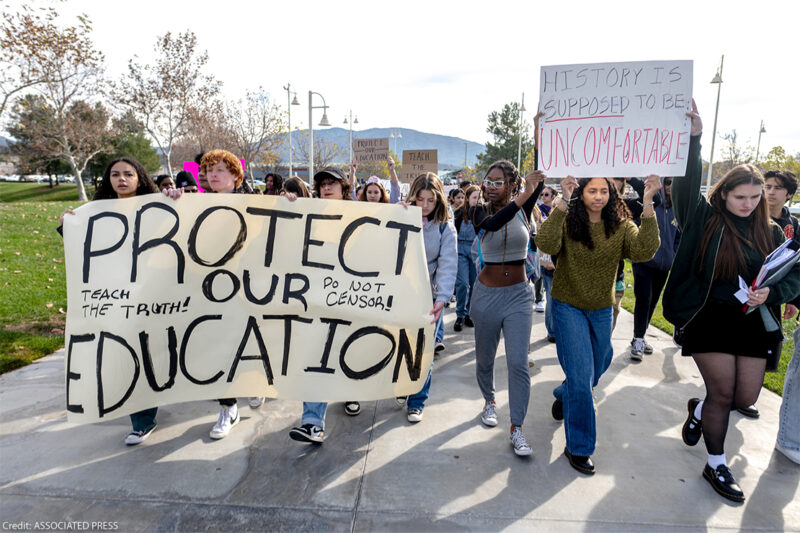What the Fight Against Classroom Censorship is Really └Ž░─├┼┐¬Į▒Įß╣¹


The └Ž░─├┼┐¬Į▒Įß╣¹ is leading the fight to end classroom censorship and protect our right to learn. We filed the first case in the country to challenge a law that censored instruction about systemic sexism and racism in Oklahoma, survived a motion to dismiss in New Hampshire, and obtained an injunction to block the State of Florida from enforcing the higher education provisions of the Stop W.O.K.E. Act.
As a former high school history teacher and a lawyer on the └Ž░─├┼┐¬Į▒Įß╣¹ team litigating these challenges, the threat these laws pose to society is truly terrifying. Conservative politicians pushing these bills are advocating for nothing less than a re-whitewashing of history. If these revisionist efforts are successful, the next generation will be compelled to believe a version of history manufactured to fit the so-called patriotic views of a vocal, discriminatory minority. Students will not be taught, and may never learn, to trace the deliberate impact of historic oppression on institutions today. This will reinforce the salience of racism, sexism, homophobia, and transphobia as unavoidable, and prevent the next generation from achieving justice.
Efforts to silence discussions about race also invalidate the lived experiences of BIPOC students. Instruction about racism and sexism belongs in schools because it equips students to process the world around them and to live in a multicultural society.
Two years into this fight, a few lessons stand out:
1. The Classroom Censorship Movement is Growing.
The push for classroom censorship ignited as backlash to progress towards racial justice following the unprecedented protests in 2020 sparked by the murder of George Floyd. To curtail efforts to expand instruction and materials about racial justice and our discriminatory history, introduced bills to limit instruction about racism and sexism. These bills, essentially education gag orders, passed in 17 states. By January 2022, 35 percent of all primary and secondary (K-12) students, or 17.7 million students, attended school in districts that experienced some form of a . To date, almost 700 efforts to exclude "critical race theory" have been identified at the local, state, and federal levels. Last year, nearly 40 percent of classroom censorship bills targeted higher education.
2. The Classroom Censorship Campaign is Driven by a Vocal Minority.
Parents that ŌĆ£lessons about the history of racism prepare children to build a better future for everyoneŌĆØ and that students should ŌĆ£learn about the ongoing effects of slavery and racism as part of their education.ŌĆØ In a 2022 study, agreed that ŌĆ£lessons about the history of racism prepare children to build a better future for everyone as opposed to feeling that lessons about racism are harmful to children.ŌĆØ Another study from 2021 found that more than that high schools should teach the impacts of slavery (78 percent) and racism (73 percent).
3. Critical Race Theory is Not All ThatŌĆÖs Under Attack.
Initially, conservatives called for the exclusion of ŌĆ£critical race theory,ŌĆØ but actually excluded so much more. All forms of race-conscious instruction have been erased from classrooms, despite their . This includes instruction about racism and discrimination (distinct from critical race theory) and culturally-relevant teaching techniques designed to build upon studentsŌĆÖ lived experiences. Additionally, conservatives banned books ŌĆö like "All Boys ArenŌĆÖt Blue" and ŌĆ£And Tango Makes ThreeŌĆØ ŌĆö and classroom instruction that highlight the experiences of LGBTQ+ people or the impact of sexism.
Educators report that they have restricted classroom discussions, curriculum, or content as a result of the laws, despite a . They described a and intimidation in schools, marked by constant surveillance, scrutiny and second-guessing.
4. Unprecedented Efforts to Control and Ultimately Rewrite History are Underway.
In accordance with FloridaŌĆÖs Stop W.O.K.E. Act, which prohibits instruction on systemic racism and sexism, the Florida State Board of Education introduced outrageous that rewrite and whitewash history. These standards require teachers to instruct students that enslaved people developed skills that could be used for their personal benefit, blame enslaved people for violence during massacres, and misrepresent the role of the Founding Fathers in .
Judge Mark Walker, who heard the case in the Northern District of Florida, accurately the Stop W.O.K.E. Act as ŌĆ£positively dystopianŌĆØ because it limits instruction to the viewpoints approved by the State, regardless of truth.
5. We Must Continue to Fight.
The conservative activist Christopher Rufo manufactured the frenzy around critical race theory in the government and schools. He described the fight against critical theory as ŌĆ£the most successful counterattack against B[lack] L[ives] M[atter] as a political movement.ŌĆÖŌĆØ It was never driven by concerns about the best interests of students.
The fight to regain or protect the status quo has obscured meaningful discussions about what was missing from education all along: the narratives and experiences of BIPOC and LGBTQ+ people and women.
Over the past two years, IŌĆÖve watched attacks on education morph from demands to exclude critical race theory from classrooms to even more dangerous demands to erase entire concepts from American history. Book bans, so-called transparency laws designed to intimidate educators into compliance and attacks on individual expression have left our education system at the mercy of a hostile and discriminatory minority. Students canŌĆÖt learn in that type of environment.
Our future depends on educational institutions that value instruction about systemic racism and sexism. We need to expand culturally relevant instruction and increase funding for diversity, equity, and inclusion in schools, not attack it for its role in uplifting the systematically oppressed. We canŌĆÖt afford to lose our education system as we know it. We must fight back.


